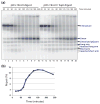Replication-coupled DNA interstrand cross-link repair in Xenopus egg extracts
- PMID: 22941607
- PMCID: PMC4100613
- DOI: 10.1007/978-1-61779-998-3_16
Replication-coupled DNA interstrand cross-link repair in Xenopus egg extracts
Abstract
Interstrand cross-links (ICL) are one of the most hazardous types of DNA damage as they form a roadblock to all processes that involve strand separation. Repair of these lesions involves several different DNA repair pathways, but the molecular mechanism is unclear. Here we describe a system that allows the examination of ICL repair, via a physiological mechanism, in vitro. This system, which uses Xenopus egg extracts in combination with a DNA template that contains a site-specific ICL, represents a unique tool to study the molecular mechanism of ICL repair.
Figures




References
-
- Walter J, Sun L, Newport J. Regulated chromosomal DNA replication in the absence of a nucleus. Mol Cell. 1998;1:519–529. - PubMed
MeSH terms
Substances
Grants and funding
LinkOut - more resources
Full Text Sources

